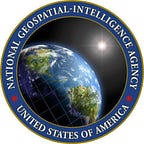NGA assists in Hurricane Matthew recovery, saves lives
‘In the early stages of a disaster, NGA is usually the first geospatial element to have eyes on the situation.’
By Samuel C. Wilson, NGA Office of Corporate Communications
In October, the National Geospatial-Intelligence Agency provided geospatial intelligence products and on-the-ground support to the Federal Emergency Management Agency, U.S. Southern Command and other first responders to aid in Hurricane Matthew recovery efforts.
NGA’s visualization products and web services with location and damage-specific information assisted federal, state and local emergency personnel in allocating resources for the overall response and recovery effort. When tasked by a lead federal agency, the geospatial information available from NGA helps emergency officials determine areas most in need of assistance and accessibility routes to individuals in need, based on impassable roads and inundated areas.
NGA’s Hurricane Matthew public website launched Oct. 5 as a single location for GEOINT data, products, consolidated tools and services to assist the U.S. government response to those affected by the storm. The website hosts over 150 products, including an interactive map of damaged areas. NGA identified more than 8,000 damaged structures, 3,300 flooded locations and 1,300 impassable road segments in Haiti and the U.S.
“Our value to the FEMA, SOUTHCOM and other first responders is the flood and damage assessments we’re providing using geospatial data,” said Brian Cameron, NGA humanitarian assistance and disaster response team lead and FEMA liaison.
FEMA uses NGA products to determine and prioritize affected populated areas in need of assistance, said Cameron.
The unclassified website is open to the public and requires no passwords. It brings together information from multiple agencies and organizations, and is available at https://nga.maps.arcgis.com/.
Domestically, NGA supported FEMA by focusing on the hardest hit areas in North Carolina and South Carolina. A team of NGA analysts also traveled to Atlanta to support deploying FEMA urban search and rescue teams.
NGA’s analysis aided several FEMA recovery program activities and operations, including preliminary damage assessments, disaster declarations, housing inspections and emergency debris removal in life-saving and life-sustaining operations.
“We’re working closely with our FEMA partners to provide real-time support and geospatial data to help them make critical decisions,” said Cameron.
Additionally, for the first time, a FEMA liaison was deployed to NGA headquarters to assist with coordination during the disaster and recovery operations.
“Working directly with NGA from the agency’s disaster analysis and domestic support team has proven to be invaluable,” said Christina Roy of FEMA’s Office of Response and Recovery, who was embedded with NGA during Hurricane Matthew. “Each agency has varied levels of geospatial resources, capabilities, processes and mission sets, so being co-located at NGA HQ allowed for a better understanding of how our teams can best work together during these types of disasters.”
Roy acknowledged that FEMA was ‘extremely grateful’ to have NGA’s continued support and forward leaning posture.
“In the early stages of a disaster, NGA is usually the first geospatial element to have eyes on the situation,” she said.
NGA’s assessments helped determine damage levels to homes and infrastructure and is in many instances the only analysis FEMA has in deciding whether or not to recommend a disaster declaration to the president, said Roy. A disaster declaration is the first step in providing financial and other types of assistance to disaster survivors.
“The support that NGA can provide through analysis of remotely sensed data gives us timely situational awareness for response program areas at the beginning of an event, and can be used throughout the event’s entire timeline,” said Roy. “When we all talk about the value of data analytics and the ‘so what’, I can’t think of a better example than NGA damage assessments and geospatial analysis.”
One unique aspect of NGA’s Hurricane Matthew response is the integration of open source information to determine the extent of the damage caused by the storm into geospatial assessments. NGA analysts used software to utilize open source data to help determine heavily-hit areas and damages caused by the hurricane.
When the hurricane first struck Haiti, NGA was able to do an initial assessment of the area using open source tools to see where the most chatter around storm damage on social media was coming from.
NGA analysts then cross-referenced this data with geospatial data in the region and found two areas around known bridges generating conversation. Analysts then refined the social media search to include the word “bridge.”
The “bridge” search confirmed there was damage to two bridges in the region. NGA analysts alerted first responders to this information and provided additional geospatial products over the affected areas.
“The use of social media is becoming increasingly helpful in disaster response scenarios because more and more people are providing real-time, valuable information publicly,” said Cameron. “We aren’t relying solely on tweets and posts, but this information can alert us to specific areas of concern, and we can then provide additional GEOINT to first responders.”
One of NGA’s core mission sets is providing accurate and timely geospatial intelligence to first responders in the wake of domestic and international natural disasters and emergencies, in support of a lead federal agency. NGA supports humanitarian and disaster response efforts by working directly with the lead federal agencies responding to fires, floods, earthquakes, landslides, hurricanes or other natural or manmade disasters.
Brian Cameron, NGA humanitarian assistance and disaster response team lead and FEMA liaison, was featured on ABC7’s Government Matters Oct. 16 to discuss NGA Hurricane Matthew recovery efforts and the public NGA website. Listen to Cameron’s interview here.
Like us on Facebook | Follow us on Twitter
About NGA: The National Geospatial-Intelligence Agency delivers world-class geospatial intelligence, or GEOINT, that provides a decisive advantage to warfighters, policymakers, intelligence professionals and first responders. Both an intelligence agency and combat support agency, NGA fulfills the president’s national security priorities in partnership with the intelligence community and the Department of Defense.
